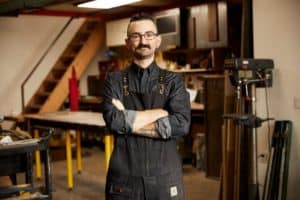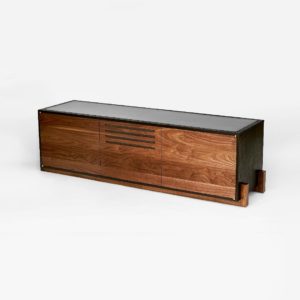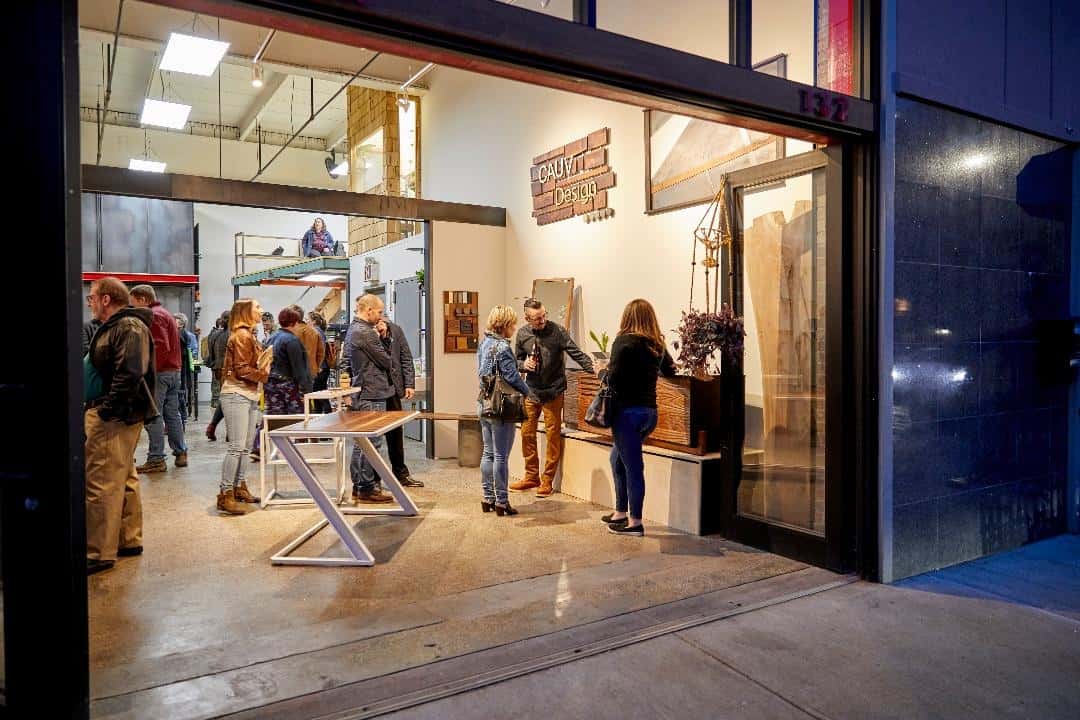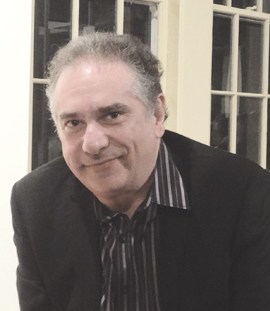CAUV Design is located at 132 Van Dyke Street in Red Hook. Modern furniture artist and owner Joseph Cauvel had a knack for building since he was a kid growing up in northwestern Pennsylvania. His father was a firefighter, who would also work a second job for a contractor.
“He always had a hobby workshop in the basement or in the garage,” Cauvel explained. “I probably cut my teeth that way without even knowing it, just wanting to hang out [with him] and be a part of it.”
Cauvel later excelled in his high school woodshop class – to the point where he would finish the projects before the teachers had even demonstrated to the class what to do – because he already knew how to use the tools.
“The teacher would have to come up with something else to keep me busy, so I became almost like a TA,” he said. “I would go around to other kids and help them get their tables done.”

After graduating high school, Cauvel started working full-time and later moved to Chicago and spent six years working in film. He became burnt out from the grind of the industry, adding it was monetarily satisfying but not something he was happy with. He started to mess with very primitive welding, getting his own little welder and restoring a ’65 Chevy pick-up truck. Then he decided to make furniture for himself and some friends and family about five years ago – “as something to try out.” And the rest is history as Cauvel and his girlfriend moved to the neighborhood three years ago and set up the CAUV Design studio.
GOING THROUGH THE PROCESSES
Metric Design Studio and CAUV Design are two entities inside of Red Hook Atelier where an idea for a furniture piece becomes a reality after much collaboration.
“When people are moving in and maybe looking to customize their units, they can walk in here and have a conversation and a handshake with the person who’s going to almost hold their hand through it, if they want,” Cauvel said. “I don’t want to do it from behind smoke and mirrors where what you see is what you get [and] you can’t customize it – that’s more [like] big box stores.”
He explains that the designing process alone can vary in length, depending on what clients are thinking. But every process always starts with taking site measurements and sketching renderings, which he initially does for free.
“Some people come to me with a very vague idea and they need me to pick their brain with questions and then narrow it down with them,” Cauvel explained. “Then there’s other people who come with a much more figured out idea, like a mom-and-pop home owner. Interior architects and interior designers already have a very good idea of what they want – they just need a very capable maker to sort of interpret it and make it for them.”
But, like any job, challenges sometimes arise.
“The challenge of custom, which I enjoy, is customizing my pieces to a different scale or finish. Every job that comes in here is different like a snowflake; there won’t be any other one like it,” he said. “Just like you can’t find two pieces of wood that are exactly the same with their grain.”
Cauvel views furniture as interactive interior architecture for people’s everyday lives – which should be functional, in addition to looking good. Once a design is agreed upon, he chooses the best materials that will fit the project at hand.
Since Cauvel specializes in wood, metal and concrete, any project can encompass one of those materials, a combination of two or even all three. But he said that, while it’s not necessary to add concrete to a potential piece, it’s fun when it does happen. While concrete’s uncommon for the likes of mirrors, desks and tables, Cauvel lets his clients know that it’s an interchangeable option. In terms of wood, his custom pieces are mostly made from domestic hardwoods, like oak and walnut that are obtained through sustainable or natural resources. For every piece sold a donation’s made to an organization that focuses on planting trees in national parks that have suffered losses due to disease, insect outbreaks and wild fires, according to CAUV Design’s website.
CREATING A NETWORK
Cauvel said that while he and his business partner can handle a range of projects with different components and materials, they often reach out to surrounding craftsmen for support.
“We have so many friends in different shops, just in Red Hook even, to where we can collaborate and join forces on larger projects,” he said. “It’s not just a random search for freelancers; it’s more of an artist network we each have.”

For example, the wood Cauvel uses comes from a wood warehouse in Rockaway; solid surfaces like granite and marble come from a supplier in Gowanus; and metal finishes on pieces are done by a powder coater right down the street. He also exclusively uses all-natural oil/wax finishes from Odie’s Oil, which is a family-owned and operated company based in Florida.
Odie’s owner, according to Cauvel, saw him on Instagram a few years ago, when he was attempting to make his own natural finish, and reached out to him via direct message. He recalled that the owner, who’s been in the business for more than 30 years, had said his company had a finish that was exactly what he needed. So Odie’s sent Cauvel a jar to try and Cauvel found it was perfect, especially because it was long lasting, durable and safe to use (chemical-wise). As a way to show thanks, Cauvel has made some ‘how-to’ videos for Odie’s social media pages and website.
LOVING RED HOOK
Cauvel certainly hasn’t regretted the decision to move to Red Hook and set up his showroom and studio here. One of things he enjoys most is the familiarity of the neighborhood and its residents.
“I couldn’t envision myself in a place like Williamsburg that you almost never see the same people, unless you go to the same coffee shop,” Cauvel said. “To be so lucky to commute on my bicycle, when I’m not moving material, and to see the same faces – it’s like a little harbor town in Brooklyn.”
For more information about CAUV Design, visit cauvdesign.com. To make an appointment to sit down and discuss a design for a custom piece, contact Cauvel at 814-282-7575 or submit an online form at cauvdesign.com/customfurniturebrooklyncontact/.
Top photo courtesy of Cauvel
Author
-

George Fiala has worked in radio, newspapers and direct marketing his whole life, except for when he was a vendor at Shea Stadium, pizza and cheesesteak maker in Lancaster, PA, and an occasional comic book dealer. He studied English and drinking in college, international relations at the New School, and in his spare time plays drums and fixes pinball machines.
View all posts
George Fiala has worked in radio, newspapers and direct marketing his whole life, except for when he was a vendor at Shea Stadium, pizza and cheesesteak maker in Lancaster, PA, and an occasional comic book dealer. He studied English and drinking in college, international relations at the New School, and in his spare time plays drums and fixes pinball machines.










